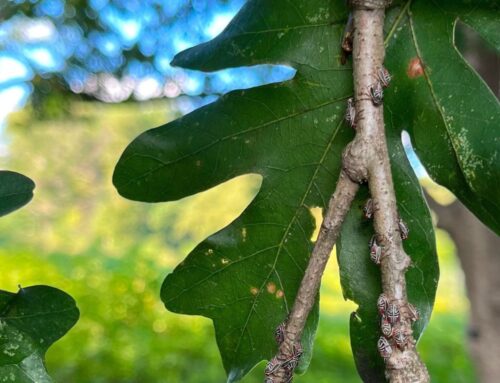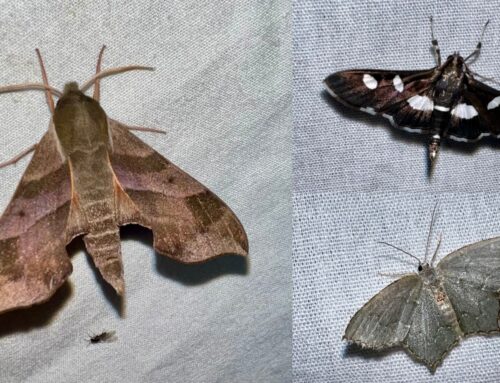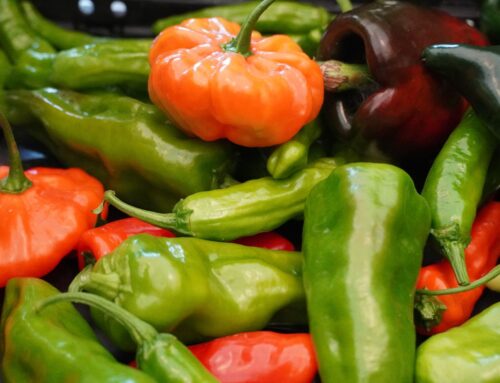When my family moved from Malaysia to Canada, one of the most difficult transitions for them was the loss of seeing greenery for months. Some family members, like my grandmother, found it very depressing to be unable to see plants growing. When I took over the gardening duties, I remembered this and started to plant broadleaved evergreens in the garden, like camellias and rhododendrons. I wanted to reassure my family that spring was near and the hope of warmer days was real. If you come out to hike Tyler, you will meet up with some of these evergreens, which will delight you until spring arrives.
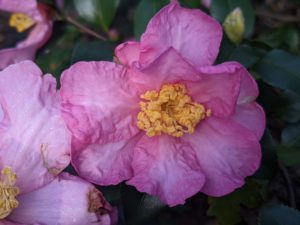
Camellia Long Island Pink
What is an evergreen? An evergreen is a plant that has foliage throughout the year. Because they have foliage during the cold winter months, they have to be ready to take on some challenges, like desiccation. All trees lose water during normal growing processes, even in winter. During the growing season when trees are in full foliage, large amounts of water are lost through their leaves. In winter, the photosynthetic process is slowed, but evergreens continue to lose water at a higher rate than deciduous trees, through their needles/foliage. This is exacerbated when the ground is frozen and the sun is out with no snow coverage. The evergreens will not be able to move water to the leaves. When evergreens are desiccated, you will see leaves browning. Snow coverage actually helps evergreens to survive as the melting snow will provide water. Simply follow one rule: site your evergreens in sheltered spots, away from winds and afternoon sun. This blog covers broadleaved evergreens. These are evergreens that do not have needled leaves like pines, spruces and firs. We will be looking at evergreens with “regular leaves.”
Coming from the far west (Pacific Northwest to be more accurate), broadleaved evergreens are near and dear to me. Working at Tyler, I get to visit them and see how they grow year to year. The evergreen that my mother requested was the camellia. Growing by Lachford and the Painter library, large and majestic Japanese camellias grow happily by the building foundation where they are sheltered from winds and sun. Here the heat sustaining stone foundation allows the camellias, which are hardy in zones 7 to 9, to flourish and bloom. Planted in 2005, our Plant Recorder, Alison Dame, tells me that they came originally from Morris Arboretum as cuttings. More camellias were planted at the Barn Garden in 2016. Even though they are small, ‘Winter Snowman’ (white) and ‘Winter Star’ (pink) have already set out bounteous blooms. We have two species of camellias at Tyler. Camellia japonica, which flowers in late winter or early spring and Camellia sasanqua, which flowers in fall. The latter is a lax shrub with smaller foliage and higher tolerance of the cold. Camellia sasanqua ‘Yuletide’ has rich, red blooms with dark, glossy leaves and can be found in the Wister Rhododendron Garden.
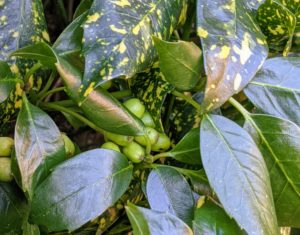
Aucuba Japonica
Not all visitors will get the chance to see another of my favorite evergreens — the spotted laurels — found at Lachford Hall. These shrubs are off the beaten path, but you can find them by taking a right when you pass the carriage shed and following the mulched path to the circle landing. Instead of descending the staircase, take the lawn and head towards Lachford Hall. Under one of the windows is a large patch of Aucuba japonica, spotted laurel. Hardy to zone 7, these shrubs have done remarkably well and thrive in the shade of the building. Commonly used in floral arrangements and as hedging plants, this large shrub is sure to please the no-fuss gardener.
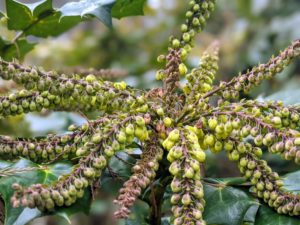
Mahonia Bealei
Retrace your steps and this time, go down the stairs and veer right. Pass the spring house on the right and stop before you come to the split rail fence. On the right is a large patch of leatherleaf mahonia, Mahonia bealei. The leaves are extremely distinctive and almost primordial in appearance. Winter is the time to visit this plant, since it blooms in February. Large clusters of yellow bloom and when pollinated, will be followed by steel blue colored fruits. Did I mention that the blooms are also fragrant, making this a winner for any winter garden? I have been told that the fruits of Mahonia aquifolium, Oregon grape, which is a close cousin to Mahonia bealei, can be made into jelly. Can these fruits be used this way? Someone, please let me know! Use your own berries and best judgement please.
The final plant on our short walk is the multicolored false-holly, Osmanthus heterophyllus ‘Goshiki’, found in the Barn Garden by a blue water spigot. You either love this plant for the foliage, or you don’t. New leaves emerge pink to bronze and mature to cream speckled on green. Yes, it looks fake, it stands out, and yes, it works well in adding winter interest. Flowers appear in late fall and are extremely fragrant. Love the fragrance of Osmanthus but prefer a native plant? Try growing an Osmanthus americanus, American devilwood. You can find a specimen in the Native Woodland Walk, as well as in the parking lot. Look carefully, as this native is very subtle and is usually only noticed in early summer when it blooms.
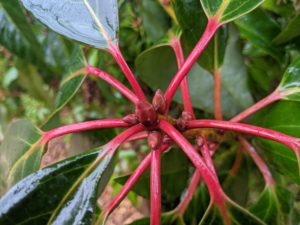
Daphniphyllum Macropodum
To see more broadleaved evergreens, you really need to head out to the Wister Rhododendron Garden in May. From our native Rosebay rhododendron to the historically significant Dexter and Nearing collections, you will be able to walk amongst specimens that are over 65 years old. With an overstory of tulip trees and skirted with a tapestry of ground covers, our 13 acre garden houses the largest collection of big leaved rhododendrons in the US.
There are many more exciting broadleaved evergreens to see, such as the rhododendron look-alike, Daphniphyllum macropodum or our trusty American holly, Ilex opaca. By the way, we have a yellow fruiting one called Ilex opaca ‘Canary’ located by Acer Field. The Daphniphyllum is tucked away near the back of the Stone House, sheltered by a large spruce. Winter is a great time to pack a thermos, bundle up and take a walk at the Arboretum. Evergreens seem to pop in the landscape now. Happy exploring!




